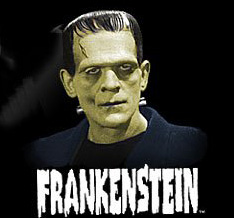Frankenstein
 From Conservapedia - Reading time: 1 min
From Conservapedia - Reading time: 1 min
Frankenstein is a gothic science-fiction novel written by Mary Shelley and first published in 1818. It describes the life and actions of Victor Frankenstein, a medical student who succeeds in animating a corpse sewn together from various body parts. The creature is at first friendly, but after it is treated harshly it becomes bitter and resolves to kill its master. After Frankenstein dies of pneumonia, the creature commits suicide. Bram Stoker cited the novel as a major influence on his novel Dracula.
This novel can be interpreted as a warning against and a condemnation of scientism. It can be considered the first science fiction novel. Its length is about 75,000 words, written at about a 12th grade reading level.
The book was the basis of the dramatic Frankenstein (1931 film), and the creature has generally been made more prominent than its creator. In pop culture, the word Frankenstein is most frequently used to refer to the monster rather than the man who gave it life, much to the displeasure of purists and pedants. Movie titles like "Abbott and Costello Meet Frankenstein" or "Bride of Frankenstein" obviously refer to the monster.
Its author, Mary Shelley, long lamented the death of her first infant shortly after childbirth. Attempts to cite Frankenstein as an allegory for abortion are liberal claptrap.
Impact today[edit]
Science magazine published one of many modern commentaries about the continuing impact of this novel, and included:
| “ | Unlike the Frankenstein character, who initially didn't consider how his work might go wrong, [J. Craig] Venter says he recognizes that editing and rewriting genomes could “contaminate the world” and cause unintended harm. “I think we need to be very smart about when we do it and how we do it,” he says.[1] | ” |
 KSF
KSF